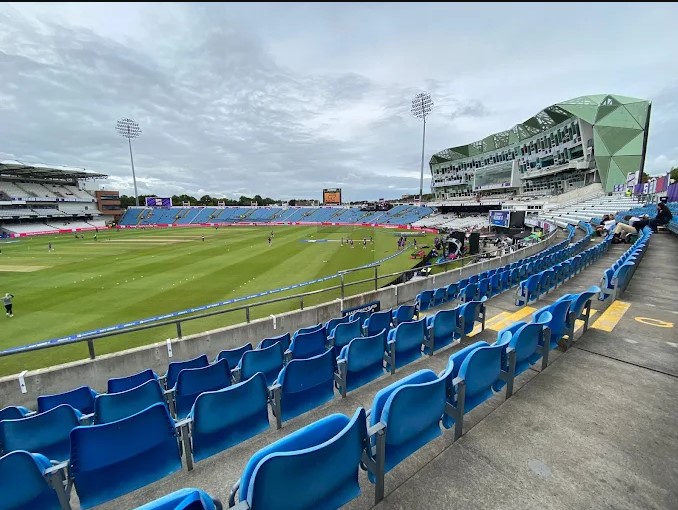Leeds Cricket Ground: Leeds, a city steeped in sporting heritage, boasts one of the most iconic cricket grounds in England: the Headingley Cricket Ground. Known for its rich history and picturesque setting, Headingley has hosted numerous memorable matches over the years, becoming a cherished venue for both players and fans alike. A crucial aspect of any cricket ground that often goes unnoticed by casual spectators is the boundary length — the distance from the pitch to the edge of the playing field. This seemingly simple metric has significant implications on gameplay, influencing batting strategies, bowling tactics, and even field placements.
Table of Contents
Overview of Headingley Cricket Ground
Headingley Cricket Ground is the home of Yorkshire County Cricket Club and has a seating capacity of around 18,350. The ground is known for its vibrant atmosphere, especially during international Test matches and domestic County Championship games.
The playing area at Headingley is oval-shaped, and like many cricket grounds, the boundary lengths are not uniform. The size and shape of boundaries vary due to natural terrain and historical developments of the stadium infrastructure.
Boundary Lengths at Leeds Cricket Ground
The boundary length at Headingley can fluctuate depending on the event or the pitch being used. However, the following table represents the typical boundary distances recorded during international matches at Headingley:
| Boundary Direction | Distance from Pitch (meters) | Distance from Pitch (yards) |
|---|---|---|
| Straight (Long On) | 65 | 71 |
| Straight (Long Off) | 66 | 72 |
| Leg Side (Square Leg) | 58 | 63 |
| Leg Side (Mid-Wicket) | 60 | 66 |
| Off Side (Point) | 63 | 69 |
| Off Side (Cover) | 64 | 70 |
| Off Side (Extra Cover) | 66 | 72 |
| Straight (Mid On) | 62 | 68 |
Analysis of Boundary Lengths
- Shorter Boundaries on the Leg Side: One of the key features of Headingley’s boundary layout is the relatively shorter leg side boundaries. For instance, the square leg boundary at 58 meters is notably shorter than the long off boundary at 66 meters. This can encourage batsmen to target leg-side shots, knowing the risk-reward balance favors boundaries in that region.
- Wider Off-Side Boundaries: The off side, especially from point to extra cover, tends to have longer boundaries, ranging from 63 to 66 meters. This typically encourages more cautious play on the off side and can influence the fielding team to strengthen that area with additional fielders.
- Straight Boundaries are Consistent: Straight boundaries like long on, long off, and mid on hover between 62 and 66 meters, offering a balance for both batsmen and bowlers. Fast bowlers often exploit these straight boundaries by bowling yorkers or bouncers.
Impact of Boundary Lengths on Gameplay at Leeds
Batting Strategy
The unique boundary dimensions at Headingley shape batting strategies significantly. Batsmen aware of the shorter leg-side boundaries might choose to play more leg glances, flicks, or sweeps to exploit the shorter distances. Conversely, the longer off-side boundaries require well-timed and powerful shots, often favoring technically adept batsmen.
Bowling Tactics
For bowlers, particularly seamers at Headingley who often rely on swing and seam movement, knowledge of boundary lengths helps in setting fields and planning deliveries. Bowlers might bowl a line and length that forces batsmen to play towards longer boundaries, increasing the chance of containment and building pressure.
Field Placements
Captains use the boundary dimensions to place fielders optimally. At Headingley, it’s common to see more fielders on the off side boundary during limited-overs cricket, where batsmen might aim for big shots, and a tighter leg side field to prevent easy fours due to shorter boundaries.
Comparing Headingley with Other Iconic Grounds
To put Leeds Cricket Ground’s boundary lengths in perspective, here is a comparison with two other famous English cricket grounds: Lord’s and Old Trafford.
| Ground | Average Boundary Length (meters) | Notes |
|---|---|---|
| Headingley (Leeds) | 62 | Uneven with shorter leg side |
| Lord’s (London) | 69 | Larger, more balanced boundaries |
| Old Trafford (Manchester) | 65 | Slightly longer off side |
As seen, Headingley has relatively shorter boundaries compared to Lord’s and Old Trafford, making it a more favorable ground for batsmen looking to clear the ropes, especially on the leg side.
Historical Boundary Length Changes
Over the decades, Headingley Cricket Ground has seen several changes in boundary dimensions. Early matches in the 19th century featured smaller playing areas due to space constraints. Modern developments, including expansions in spectator stands and facilities, have slightly altered the playing field dimensions, leading to the current configuration.
The boundary lengths at Leeds Cricket Ground are an integral part of what makes Headingley a unique and exciting venue in world cricket. The shorter leg-side boundaries and slightly longer off-side ones add an extra layer of strategic depth to matches played here. Players, captains, and coaches alike must factor in these dimensions to maximize performance.
For fans, understanding boundary lengths offers insight into the tactics at play and the thrilling nuances that unfold with every match. Whether it’s the roar following a six over the square leg boundary or the tactical battles on the off side, Headingley continues to charm cricket lovers with its distinctive ground features and rich cricketing culture.


